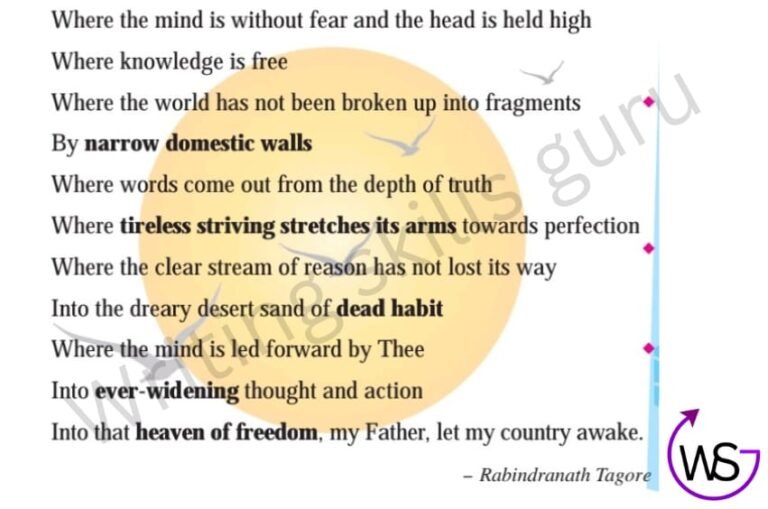
Table of Contents
ToggleWhere the Mind Is Without Fear Appreciation In Point Format
Title: Where the Mind is Without Fear
Poet: Rabindranath Tagore
The Central Idea: This is a poem where the poet hangs out most of his views on a free and enlightened India that seeks freedom from fear and division while emphasizing knowledge, truth, and reason.
Rhyme Scheme: This is a free-verse poem; it has no rhyme scheme.
Figure of Speech:
Metaphor: “Narrow domestic walls” is used as a metaphor for partitions in society.
Personification: This is clear in “tireless striving stretches its arms,” where striving is given human-like qualities common in the act of stretching one’s hands.
Special Feature: The poem reflects the nationalist feelings of Tagore and his desire for India to get real freedom together with progress. The verse is a part of Tagore’s collection “Gitanjali,” originally written in Bengali.
My Favorite Lines:
“Where the mind is without fear and the head is held high”
“Into that heaven of freedom, my Father, let my country awake.”
Why I Like the Poem: I like it because it gives hope and a vision of a future that is better. It is important in whatever society with values of truth, knowledge, and togetherness. The language is simple but powerful, hence sound and strong in putting the message across.
Where the Mind Is Without Fear Appreciation In Paragraph Format- 1
“Where the Mind is Without Fear” is a poem by Rabindranath Tagore that talks about his dream for a free and wise India. Tagore wants a country where people live without fear and with pride. He dreams of a place where everyone can learn and where people are not divided by things like caste or religion.
Tagore hopes for a society where people speak the truth from their hearts and work hard to be perfect. He wants people to think clearly and logically, not follow old, useless habits. The poem has no specific rhyme scheme, so it feels natural and smooth.
Tagore uses special ways of writing in the poem. He uses metaphors like “narrow domestic walls” to talk about social divisions and personification when he says “tireless striving stretches its arms.” These make the poem more definitive and meaningful.
One special thing about the poem is that it is part of Tagore’s famous book “Gitanjali,” which won the Nobel Prize in Literature. The poem shows Tagore’s deep love for his country and his wish for India to be truly free and progressive.
Some of my favourite lines are “Where the mind is without fear and the head is held high” and “Into that heaven of freedom, my Father, let my country awake.” These lines give hope and a vision for a better future. I like this poem because it talks about important values like truth, knowledge, and unity in a simple and strong way. The message is clear and powerful, making it a memorable and inspiring poem.
Where the Mind Is Without Fear Appreciation In Paragraph Format- 2
“Where the Mind is Without Fear” is a poem by Rabindranath Tagore that speaks of his dream of India that is free and educated. Tagore desires the nation to be without fear and the people able to hold their heads high with pride. He imagines a place where knowledge is free to all without any limitation, and the world is not burst into small pieces by narrow domestic walls. By domestic walls, he refers to the various man-made boundaries that came with time in Indian society, like those of caste, religion, and so on, that divided people and limited them to a little shell of their own.
Tagore dreams of such a society where truth is inside people’s hearts, and everybody feels so dedicated to perfection. He desires some sensible working practices to direct actions in a place where individuals are not bound to their old habits and traditions. The poem is written in free verse, so it does not follow a specific rhyme scheme, hence it comes naturally and flows.
Tagore employs multiple figures of speech in the poem. He uses flights of metaphors—for example, “narrow domestic walls” for social divisions and personification with the explanation about the “tireless striving” stretching its arms. These literary devices help in creating the images and making the passage of the deeper meanings.
One interesting point about the poem is that it was part of the brilliant collection “Gitanjali,” which was purified under the receipt of the Nobel Prize for Literature. This poem is an image of Tagore’s views of personal patriotism regarding his country and his desire for real freedom and progress. Some of the lines I like best from the poem include “Where the mind is without fear and the head is held high” and “Into that heaven of freedom, my Father, let my country awake.” The lines convey hope and a vision for a better tomorrow. That is exactly why I like the poem. It speaks simply and honestly to so many important values: truth, knowledge, unity, etc. The message is clear and forceful; hence, it becomes memorable and very, very inspiring.

